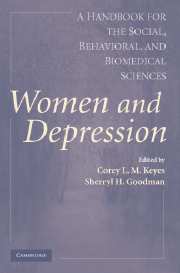Book contents
- Frontmatter
- Contents
- List of Contributors
- Foreword
- Preface
- PART I NOSOLOGY, MEASUREMENT, AND THE EPIDEMIOLOGY OF WOMEN AND DEPRESSION
- PART II BIOLOGICAL, DEVELOPMENTAL, AND AGING MODELS OF RISK
- PART III COGNITIVE, EMOTIONAL, AND INTERPERSONAL MODELS OF RISK
- 7 Cognition and Depression
- 8 Personality and Depression in Women
- 9 The Social Costs of Stress
- 10 Marriage and Depression
- 11 Depression in Women Who Are Mothers
- PART IV SOCIAL, POLITICAL, AND ECONOMIC MODELS OF RISK
- PART V SYSTEMS AND PROCESSES OF TREATMENT, PREVENTION, AND POLICY
- Author Index
- Subject Index
- References
11 - Depression in Women Who Are Mothers
An Integrative Model of Risk for the Development of Psychopathology in Their Sons and Daughters
Published online by Cambridge University Press: 05 June 2012
- Frontmatter
- Contents
- List of Contributors
- Foreword
- Preface
- PART I NOSOLOGY, MEASUREMENT, AND THE EPIDEMIOLOGY OF WOMEN AND DEPRESSION
- PART II BIOLOGICAL, DEVELOPMENTAL, AND AGING MODELS OF RISK
- PART III COGNITIVE, EMOTIONAL, AND INTERPERSONAL MODELS OF RISK
- 7 Cognition and Depression
- 8 Personality and Depression in Women
- 9 The Social Costs of Stress
- 10 Marriage and Depression
- 11 Depression in Women Who Are Mothers
- PART IV SOCIAL, POLITICAL, AND ECONOMIC MODELS OF RISK
- PART V SYSTEMS AND PROCESSES OF TREATMENT, PREVENTION, AND POLICY
- Author Index
- Subject Index
- References
Summary
Driven both by knowledge of higher rates of depression in women than men and by assumptions about incompatibilities between depression and good quality parenting, research on children with depressed mothers has soared over the past few decades. In an attempt to account for the many factors involved in the transmission of risk for psychopathology from depressed mothers to their offspring, goodman and Gotlib (1999) developed an integrative and developmentally sensitive model for understanding mechanisms whereby children of depressed parents might be at risk for the development of psychopathology. The model is consistent with the premise for this book in that it takes a bio-psycho-social perspective on mechanisms and, therefore, we use it as the framework for this chapter. We move beyond previous reviews by examining the current empirical status of each of the proposed mechanisms within this framework. Further, given this book's focus on women and depression, we explore the extent to which daughters may be more affected by their mothers' depression than sons, that is, gender specificity in the intergenerational transmission of depression. Finally, we draw implications from the current status of the model overall and of gender specificity, in particular, for further research as well as potential steps for prevention, treatment, and social policy.
This chapter begins by briefly describing the reasons for concern about children with depressed mothers, including the nature and extent of associations between depression in mothers and adverse outcomes in children, across the full age range from infancy to adolescence.
- Type
- Chapter
- Information
- Women and DepressionA Handbook for the Social, Behavioral, and Biomedical Sciences, pp. 241 - 280Publisher: Cambridge University PressPrint publication year: 2006
References
- 45
- Cited by



